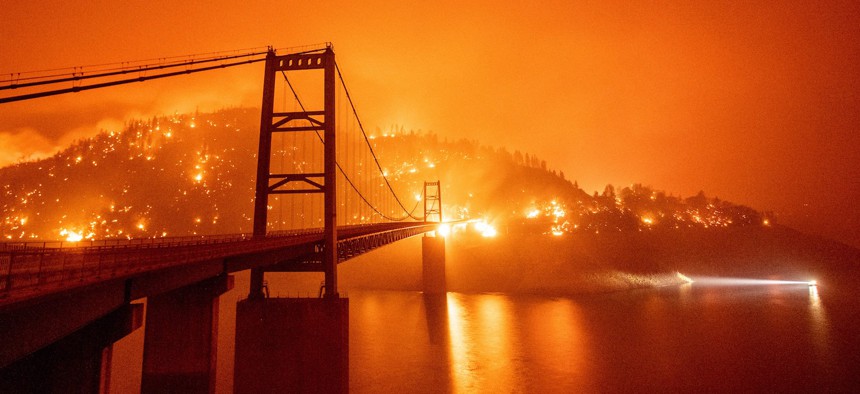
The Bidwell Bar Bridge is surrounded by fire in Lake Oroville during the Bear fire in Oroville, Calif. on September 9, 2020. NASA and the FAA are collaborating on an effort to use drone technology to battle wildfires. Josh Edelson/AFP via Getty Images
Bipartisan bill seeks to grow NASA program using drones to fight wildfires
New legislation attempts to improve NASA’s Advanced Capabilities for Emergency Response to Operations program so firefighters can more effectively use drones.
House lawmakers introduced bipartisan legislation this week that would expand a NASA initiative designed to use drones and other advanced aviation technologies to assist with wildfire prevention and mitigation efforts.
The bill — introduced on Tuesday by Reps. Mike Garcia, R-Calif., and Jennifer McClellan, D-Va. — would bolster NASA’s Advanced Capabilities for Emergency Response to Operations program, or ACERO, “to improve aerial responses to wildfires.”
According to NASA, the ACERO program is developing “airspace management technologies to share information between crewed aircraft, drone operators and ground crews during wildfire responses.”
The lawmakers said in a press release that their legislation would “codify, expand and improve the existing ACERO project at NASA” and grow the initiative further “to include research and development of new technologies related to the management, deconfliction and coordination of manned and unmanned aerial vehicles in wildfire response.”
The bill would also require ACERO to create “a unified concept of operations for the management of airspace during wildfires,” which would include input from federal, state and local officials and industry and academic partners.
McClellan said the legislation would “improve the coordination of manned and unmanned vehicles” used to combat wildfires and ensure that “the United States remains on the forefront of innovation and supports our firefighters and other first responders as they protect the American people.”
Garcia also highlighted the importance of using advanced aviation technologies to assist with wildfire mitigation efforts, saying that firefighters in his district have pressed for the use of drones to bolster their emergency response capabilities.
“These unmanned aerial vehicles can quickly detect and reach small or remote fires to stop them from growing out of control — improving response times and keeping firefighters out of harm’s way,” Garcia added. “These UAVs can also support operations at night — assisting emergency responders when visibility is low and manpower is reduced.”
NASA is already working to expand its cross-agency collaboration to create more effective wildfire mitigation strategies and aviation systems that can better assist firefighters. The space agency announced on April 19 that it established a four-year partnership with the Federal Aviation Administration to expand its ACERO program to “develop new airspace access and traffic management concepts and technologies to support wildland fire operations.”

